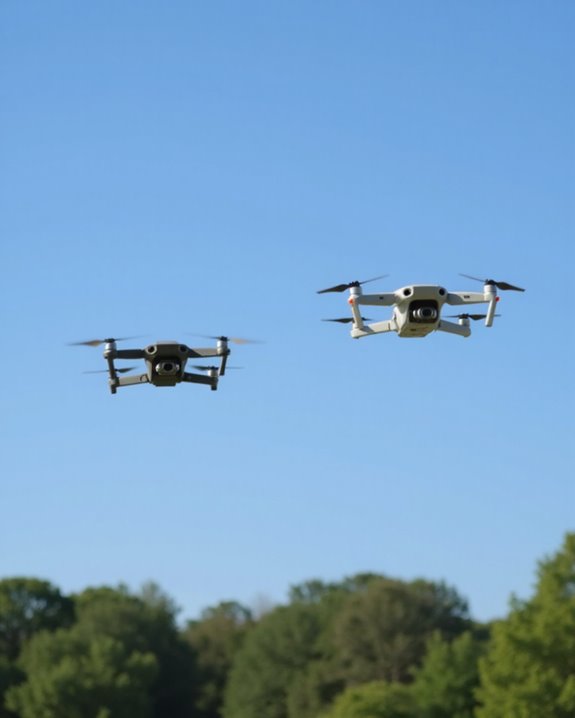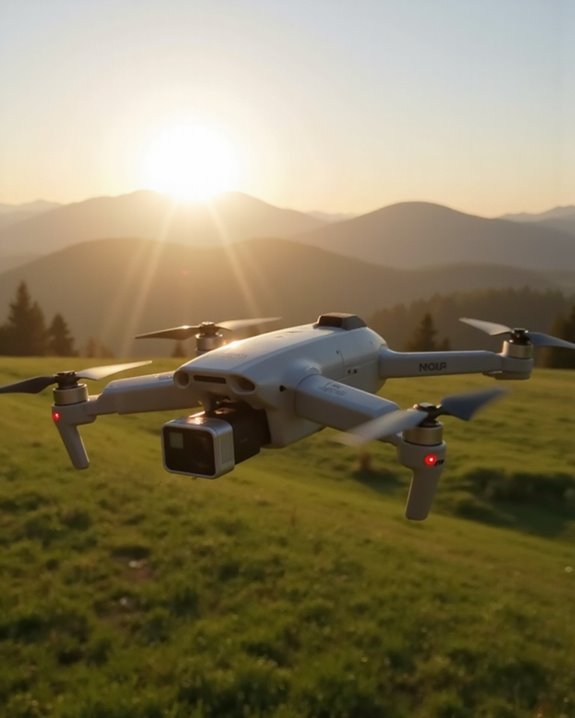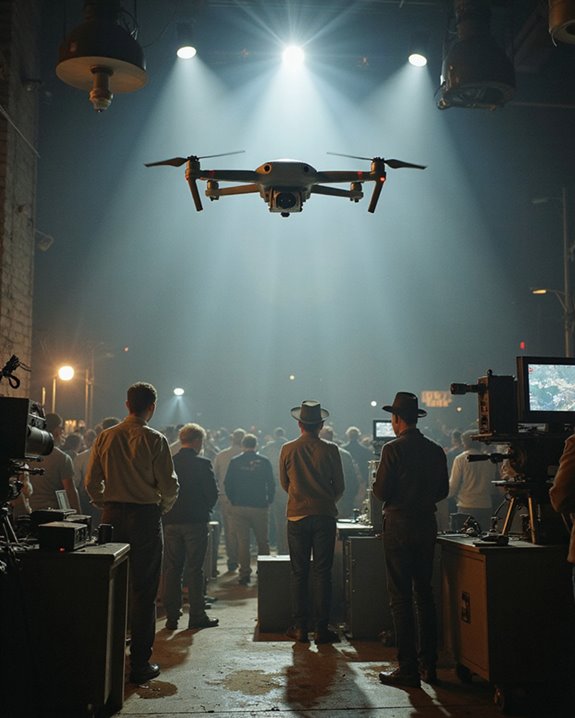Dedicated video drones outperform iOS drones in key areas including flight time, wind resistance, and image quality. With up to 51 minutes airtime compared to iOS devices’ shorter battery life, models like the DJI Mini 4 Pro offer superior stabilization and larger sensors for better low-light performance. However, iOS drones excel in ecosystem integration and cost-effectiveness for Apple users. Your specific needs—whether professional-grade footage or casual aerial photography—will determine which option delivers the best value for your aerial adventures!
Key Takeaways
- Dedicated video drones offer superior flight time (up to 51 minutes) compared to iOS drones, enabling longer filming sessions.
- Dedicated drones have larger image sensors and 3-axis gimbals, producing better low-light footage and smoother stabilization.
- Physical controllers with dedicated buttons and bright displays provide more reliable control than touchscreen interfaces in various conditions.
- iOS drones integrate seamlessly with Apple’s ecosystem but lack the wind resistance and obstacle sensing of dedicated drones.
- Dedicated drones require higher initial investment but offer better image quality, flight performance, and typically maintain stronger resale value.
Evaluating Compatibility and Ecosystem Integration
When it comes to choosing between video drones and iOS drones, compatibility considerations often make or break the user experience. While dedicated video drones require specific hardware setups, iOS devices offer a streamlined ecosystem that many users already understand. This familiarity can be a huge win for drone pilots just starting out!
Cloud Integration capabilities vary greatly between these options. iOS drones typically connect seamlessly with Apple’s ecosystem, making data storage and sharing remarkably straightforward. Meanwhile, dedicated video drones often excel with third-party cloud services and broader API Standards that allow for greater customization and interoperability. Android-based systems, with their open nature, typically support more diverse connection protocols than iOS, giving tech-savvy users more room to tinker and perfect their aerial photography setup. Additionally, advanced drones like the N11 PRO feature dual positioning systems that enhance flight stability both indoors and outdoors, improving user control and safety.
Flight Performance and Processing Power Comparison
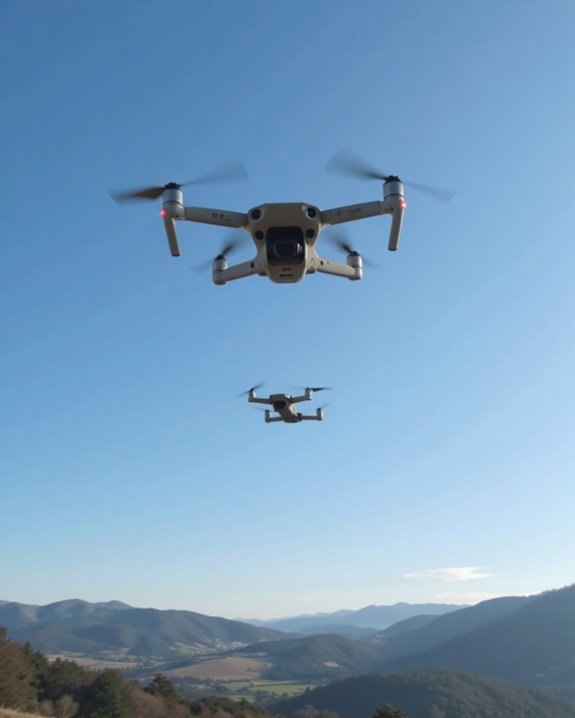
Beyond compatibility issues, the raw performance capabilities of different drone systems reveal stark contrasts that every aerial photography enthusiast should understand.
Dedicated video drones excel in Wind Resistance, enabling smoother footage capture even when Mother Nature gets moody! Models like the DJI Mini 4 Pro feature advanced stabilization systems and omnidirectional sensors that dramatically enhance flight stability in challenging conditions. The Processing Algorithms in these purpose-built machines are specifically designed to handle high-resolution video, delivering superior real-time transmission and more efficient data management.
While iOS-based systems benefit from Apple’s powerful processing chips, they simply can’t match the flight duration of dedicated drones, some offering up to 51 minutes of air time. For serious aerial photographers, the difference becomes clear when shooting in variable weather or complex environments where stability matters most. Additionally, many dedicated drones come with omnidirectional obstacle sensing that greatly improves safety and autonomous flight capabilities.
Control Systems and User Experience Analysis

The battle between control systems represents perhaps the most tangible difference pilots experience when choosing between video drones and iOS drones. Dedicated controllers offer distinct advantages through physical buttons that provide Haptic Feedback, creating a more intuitive piloting experience that smartphone touchscreens simply can’t match! With ultra-bright displays (1000 cd/m²) that outshine typical iPhones, these purpose-built controllers excel in harsh sunlight where iOS screens might leave you squinting.
Meanwhile, iOS drones leverage Apple’s seamless ecosystem, with many supporting Gesture Controls that allow pilots to capture dramatic shots with simple hand movements. The tradeoff? You’re stuck with touchscreen-only interactions and potentially shorter battery life. For serious pilots, dedicated controllers provide those reassuring physical switches and fail-safe buttons that just feel right when you’re flying a $1,000+ aircraft through the sky! Additionally, controllers like the Radiolink T12D offer 2.5-mile range and anti-interference technology for stable, long-distance control.
Camera Quality and Video Production Capabilities
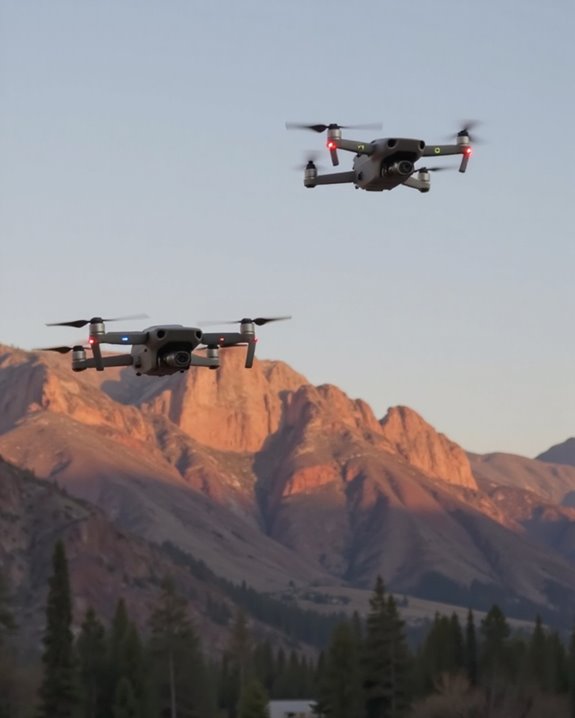
While control systems put you in command of your drone, camera quality determines what you’ll capture once you’re airborne! The difference between dedicated video drones and iOS systems often comes down to Sensor Technology – dedicated drones typically house larger sensors that capture stunning detail even as the light fades.
When comparing a DJI Mavic 3 with its micro 4/3 sensor to an iPhone drone attachment, the difference is striking. The dedicated drone delivers superior Dynamic Range, preserving both shadow details and bright highlights in challenging lighting conditions. Professional filmmakers particularly appreciate the advanced stabilization systems and manual controls that dedicated drones offer. Want those silky-smooth cinematic pans? A 3-axis gimbal will deliver results that even the best iOS stabilization can’t quite match! The choice ultimately depends on your quality requirements and budget considerations.
Budget Considerations and Value Assessment

Making financial decisions about drone technology ultimately comes down to aligning your budget with your creative ambitions. When evaluating Budget Tradeoffs, consider that iOS drones leverage your existing iPhone hardware, potentially saving hundreds on controllers and viewing screens, while dedicated video drones require higher upfront investment but often deliver superior image quality per dollar spent.
Value Tradeoffs become evident in daily operation—iOS drones minimize accessory costs through universal smartphone add-ons, while dedicated models demand proprietary parts that add up quickly! Flight time differences also impact value; the DJI Mini series offers impressive 34-51 minute endurance compared to many iOS-compatible models. Remember, dedicated drones typically maintain better resale value, softening the initial financial blow. Your choice should reflect whether convenience and cost efficiency outweigh professional feature sets for your specific creative needs.
Practical Limitations and Real-World Applications

Beyond budget considerations, practical capabilities define what you can actually accomplish with your drone in real-world scenarios. Dedicated video drones often demonstrate superior performance in challenging Weather Effects, maintaining stability during gusty conditions when iOS-based alternatives might struggle. Their robust operating systems also handle Legal Restrictions more effectively, with built-in geofencing and altitude limitations that keep you flying safely!
iOS drones, while convenient, sometimes face compatibility issues across different Apple devices. Meanwhile, dedicated systems from brands like DJI and Autel offer enhanced omnidirectional sensors and obstacle avoidance features that prove invaluable during professional filming sessions. The difference becomes particularly noticeable when conducting aerial surveys or commercial work, where stability and reliable video transmission aren’t just nice-to-haves — they’re absolute necessities for getting the job done right.
Frequently Asked Questions
How Do Weather Conditions Affect Ios Drones Versus Dedicated Drones?
Weather conditions greatly compromise iOS drones’ stability and longevity. Dedicated drones offer superior storm performance with better weatherproofing and autonomous adjustment capabilities. Their advanced systems also provide enhanced fog resilience compared to more vulnerable iOS alternatives.
Can I Legally Fly Drones in National Parks With Either System?
Neither iOS drones nor dedicated video drones can be legally flown in national parks. Park regulations prohibit all drone usage regardless of control system, with legal exemptions only for scientific research or search and rescue operations.
How Do Dedicated and Ios Drones Compare for Indoor Flying?
Like birds in a confined aviary, dedicated drones offer superior Flight Stability and Indoor Navigation with omnidirectional sensors, while iOS drones provide convenience but typically lack the precision controls needed for confined spaces.
What Privacy Concerns Exist When Using Phone-Controlled Versus Dedicated Drones?
Phone-controlled drones raise concerns about app permissions and data sharing, while dedicated drones present fewer privacy invasion vectors. Both systems face hacking risks and must comply with privacy regulations governing data collection and transmission.
How Do Cellular Interference Patterns Affect Ios Versus Dedicated Drone Performance?
Dedicated drones employ specialized interference mitigation techniques that extend cellular range at altitude, while iOS drones suffer from network connections optimized for ground users, resulting in greater performance degradation when encountering cellular interference patterns.

